If you’re looking to get some great photos of penguins, the Falkland Islands is a wonderful location to capture a variety of penguin species.
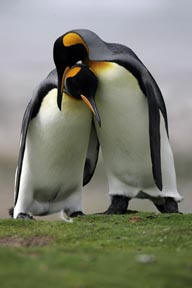
King Penguins
As you rumble down the airstrip in a small 8-seat propeller plane, you look out the window, brimming with excitement. The trip took several months planning, so you hope you won’t be disappointed. You’re met at the plane with a 4-wheel drive vehicle and whisked off to your accommodations. Along the way, your excitement level increases.
As your transportation motors along, you’ll see a number of penguins, which is exactly why you came to the Falkland Islands. With rolling grass-covered hills, cliffs and beaches, they’re not in a setting that first comes to mind for penguins. Recent movies, like “Happy Feet,” always situate penguins on arctic icebergs, but there are plenty of them in the Falklands. In fact, there are five species to be found, the King Penguins, the Gentoo Penguin, the Rockhopper Penguin, the Magellanic Penguin, and the Macaroni Penguins.
It’s late afternoon, and you’re asked if you’d like to take a ride out to one of two drop-off points for an evening of photography. You’re thinking to yourself, “Are they crazy? Of course I want to go out!” You answer the host politely and scurry off to get your gear ready to go out and start taking photos of whatever you find. And what you find are penguins all over the place. On the way to the drop off, your vehicle must swerve in order to miss a number of holes in the ground. As it turns out, these holes are actually nesting burrows built by Magellanic Penguins. Almost everywhere they inhabit, you’ll see a penguin popping its head up from one of these burrows.
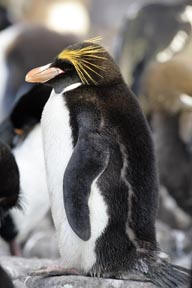
Macaroni Penguin
It’s summer in the Falklands, and the penguins are nesting. No matter which island and penguin colony you visit, you’re sure to find parents sitting on an egg, fluff-ball nestlings, or juveniles ready to go out fishing on their own. It doesn’t take long to realize you made a good choice to venture all the way south to try and see and photograph a lot of different penguins.
My visit had two goals. The first was to add penguin images to my photography files, and the second was to scout out a new and exciting photo workshop. Months earlier, I’d been going through back issues of magazines to cut out articles of interest. Several of them had articles about penguins in the Falkland Islands. Two of the magazines covering this subject were published four years apart. I guess they were telling me it was something I must do, and I’m glad I followed that lead. About 6,500 photos later, I knew I had made the right decision.
I’d hoped to visit three of the outer islands on this trip. Unfortunately with waiting until late in the year to make reservations, I could only get to the main island and two of the outer islands. This proved to be more than enough.
My first stop was Saunders Island. The island has two primary locations for bird viewing and photography. One area is called “The Rookery.” It has colonies of Rockhopper Penguins and Black-browed Albatross. I first came across the albatross colony, and it was hard to leave them for the Rockhopper location. When conditions are right, you’ll witness adult albatross gracefully soaring just off the cliffs at eye-level. Take-offs are not quite so graceful. Albatross require a running start to take flight. There are several areas you can sit in the grass at spectator level, and watch them stumble by for takeoff, a mere 10 feet in front of you.
It doesn’t take long to notice that the animals of the Falklands aren’t afraid of humans. In fact, one group of adolescent Gentoo Penguins went out of their way to surround me, carefully observing what I was doing from only a foot or two away. Once they realized I didn’t have anything to eat, they waddled back to their colony.
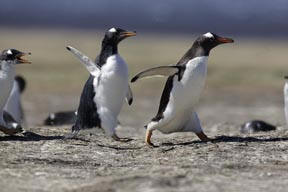
Gentoo Penguins
Once I made my way to the Rockhopper Penguin colony at The Rookery, I was treated to an unusual sighting, a Macaroni Penguin. While they call the Falkland Islands home, they usually reside in harder to reach areas. Luckily for me, a few were mixed in among the Rockhopper Penguins.
The other viewing spot on Saunders Island is called “The Neck.” It’s a small isthmus where the diversity of subjects will keep you enthralled from dawn ’til dusk. And because the light is always at a low angle, when it’s out, you are able to do photography all day long. This area supports a colony of Rockhopper Penguins, a colony of Gentoo Penguins, and plenty of Magellanic Penguins, but the main attractions are the King Penguins. They come to this spot to nest and raise their young. Although there are usually only about 18 of these majestic birds, that’s more then enough to keep you sitting just a few yards away watching and photogaphing their behavior. This is the best thing about going to the Falklands. You can sit fairly close to all of the birds you can learn quite a bit about them with their behavior patterns, feeding behaviors and other aspects of their interaction with each other. The other place on the islands to watch the King Penguin is from the main town of Stanley. Volunteer Point has upwards of 1,000 of these beautiful birds, which are very similar to the Emperor Penguins but about 6-8” shorter.
There are 18 locations throughout the Falklands that have at least one species of penguin or nesting birds, but not all are set up for overnight accommodations. On my trip, while I wanted to go to three of the outer islands, I was only able to get to two. For future trips running workshops, I’ll try to work in three different shooting locales including Volunteer Point. One thing to keep in mind when planning a trip here, you have to give a little bit of leeway for the weather. I was scheduled to go back to Stanley for a trip to Volunteer Point for the King Penguin colony, but 70 mph winds kept all of the small planes grounded and I missed this opportunity.
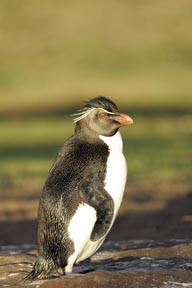
Rockhopper Penguin
That didn’t matter though as the island I was on at that time, Sea Lion Island, had more than enough to make for good photo opportunities. There you’ll find a Gentoo Penguin colony with lots of action, and it’s situated very close to the guest building. Within a few minutes walk from that spot, is a beach inhabited by Southern Elephant Seals. The same beach has Magellanic Penguins swimming ashore after their ocean fishing excursions. It’s very easy to get close-up viewing of them bobbing about out in the water. A bit further away, Rockhopper Penguins and King Cormorants can be found. The easiest flight photography I’ve ever encountered was of the King Cormorants returning to shore after their ocean fishing adventures.
Planning way ahead to get to where you really want to go is a must. As soon as I arrived back from my trip in January, I started making plans for my trip the following year for a workshop and I couldn’t get everything set the way I wanted. I was still able to put together a real good trip but one of the places I wanted to go I couldn’t, as there was no space available, and this was a year in advance. With very limited accommodations on each of the islands, maybe 10 to 12 people maximum and some only 6 or 7, it makes for a superb trip with knowing you won’t be run over by a lot of people.
This trip is sure to be on my workshop schedule for years to come and space will be limited due to the number of beds available. To see next year’s schedule you can visit my Falklands trip schedule at http://www.firstlighttours.com/falklands_penguin_photo_workshop.html.
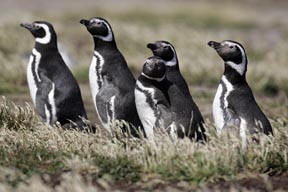
Magellanic Penguins
By Andy Long

Leave a Reply